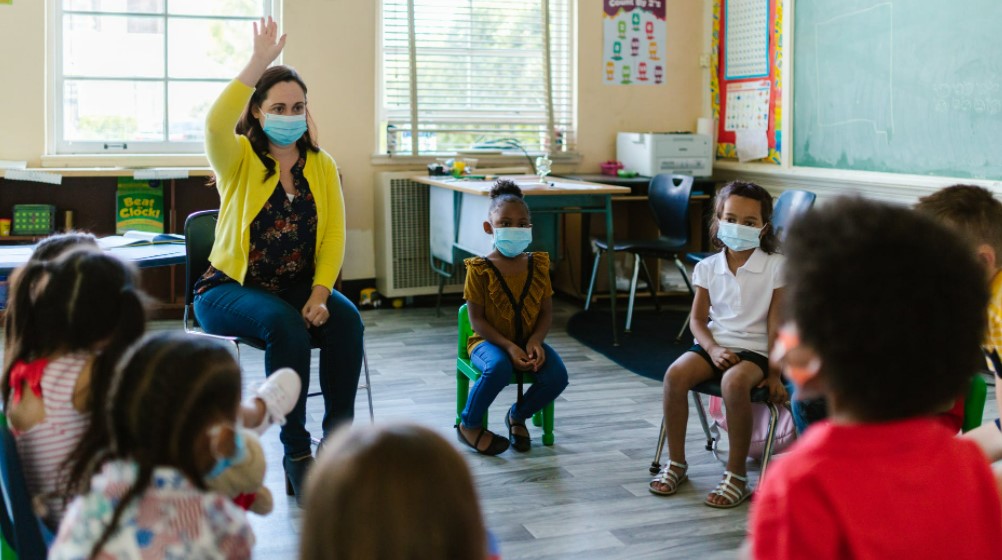
British Columbia Child Care Workforce Development Snapshot
By Brenda Kent, Director of Government Relations and Advocacy at the YMCA of Greater Vancouver
British Columbia launched its Child Care B.C. plan in February 2018, promising greater accessibility, affordability and a high quality of early learning and care. Since then, the province reports allocating $2.4 billion to the child care system, signifying a long-term commitment to working towards universal child care.
Throughout the provincial plan, the needs of B.C.’s early learning and care (ELC) workforce are illuminated. For instance, to meet targets laid out in the plan around space creation and affordability, the most pressing and urgent issue is the workforce shortage of ELC professionals. However, enticing professionals into this field and retaining those already there is a challenge that advocates have been raising for years. ELC professionals are central to high-quality child care, yet it is widely recognized that wages, working conditions and a lack of recognition of the profession have contributed to a serious workforce shortage. In response to this long-term problem, the province unveiled its Early Care and Learning Recruitment and Retention Strategy in the fall of 2018 to stabilize and grow the workforce.
Child care stakeholders in B.C. have done a deep dive into the ELC workforce over the past few years with numerous evaluations and reports capturing labour market issues. This brief snapshot highlights some of the initiatives supporting, and attempting to grow, the ELC workforce.

B.C.’s child care system
Licensed early learning and child care in B.C. is delivered by a mix of private, non-profit, Indigenous, and public providers. Nearly half of the spaces are operated by for-profit providers, with the balance made up of non-profit, Indigenous, public-sector, and family providers (in-home child care).
Fees for group child care programs are highest in for-profit settings, followed by non-profit and family child care. For example, in 2020-21 on average, infant/toddler spaces in for-profit centres were $1,350 per month compared to $1,200 per month in non-profit programs and $1,000 per month in family child care. Fees vary across the province with Vancouver parents paying among the highest fees across Canada for infant and toddler care.
The financial model for reducing parent fees while also boosting wages must include adequate government investments — for most non-profit operators, staff wages and benefits represents 80 to 85 percent of operating costs, leaving 15 to 20 percent for all other operating costs and administration. Affordability of child care is being addressed in a variety of ways through provincial and federal funding, with a goal of $10-a-day child care across B.C.

B.C.’s ELC workforce
The ELC workforce includes several levels of trained professionals:
- Early Childhood Educators (ECEs) have completed a one- to two-year early childhood education training program that is recognized by the ECE Registry and that includes practicum placements;
- Early Childhood Educator Assistants (ECEAs) have completed one early childhood education course and support ECEs in child care programs; and
- Responsible Adults (RAs) have at least 20 hours of training.
ECEs can enhance their education through: infant and toddler or special needs credentials; additional training in child care leadership, administration and management; or post-graduate degrees in early childhood education.
ECEs and ECEAs work in various programs, from family child care programs to larger group child care centres, Indigenous early learning programs and in schools. RAs work in various child care settings and are often employed in before- and after-school programs. According to the ECE Registry, there are currently 21,502 active ECEs (up 4,000 since 2018), and 9,000 ECEAs (up 3,000 since 2018).[1],[2] This growth in the workforce reflects the creation of more spaces.
The Early Childhood Educators of B.C. led the evaluation of the province’s recruitment and retention strategy, commissioning research on the child care workforce. Among ECEs and ECEAs:
- The vast majority are women (95 percent);
- Many work part time (37 percent);
- Attending school while working is common (20 percent);
- Nearly half have children (45 percent); and
- Over half have a post-secondary education (52 percent).
B.C. has the second highest proportion in Canada of newcomers working in the child care sector at 39 percent, and Indigenous professionals make up seven percent of the child care workforce.
ECE ratios for child care are as follows:
| Staff/Child | Maximum | |
| Infant 0-36 mos. | 1:4 | 12 |
| 30 mos. – 5 yrs. | 1:8 | 25 |
| Kindergarten to grade 1 | 1:12 | 24 |
| Grade 2 and up | 1:15 | 30 |
- Workforce data collected in 2020 showed that ELC professionals made between $20.99 an hour (RAs) and $23.71 an hour (ECEs with infant/toddler and special needs certifications). Supervisors made approximately $4 an hour more than non-supervisors. The government has been addressing ECE wages through annual wage enhancements, which rose to $4 an hour in 2021, however, many ECL staff have not been eligible. B.C. Budget 2022 includes an expansion of eligibility of these wage enhancements to more ECEs who do not contribute to the ratio (e.g. supervisors, special needs ECEs), but RAs and ECEAs are still not included, widening the wage gap and affecting the before- and after-school workforce. Advocates have proposed a model for a provincial wage scale to make wages appropriate, consistent and predictable and to help stabilize the child care sector. A wage scale is now included as a priority in the $10-a-day federal-provincial child-care agreement.
The workforce shortage in child care has been a long-standing problem in B.C.
At a time when we are seeing extraordinary public investment in child care, we are seeing centres close spaces because they cannot find enough trained educators to reach their ratios.
The YMCA, as the largest provider of licensed child care in B.C., is currently experiencing a shortage of more than 108 child care staff with nearly 400 unfilled spaces due to this labour shortage. The three-year evaluation of the province’s recruitment and retention strategy showed little change in this persistent workforce shortage, coupled with the added complexities brought on by COVID-19 that contributed to more workforce instability. There is also significant regional variation; while the labour shortage is seen everywhere, the proportion of the workforce that is ECE-certified is lowest in northern communities.

Workforce development
The complexity of building up a workforce that has been in chronic shortage for decades cannot be solved overnight. It demands a comprehensive approach to address wages and working conditions, innovative education and training systems, professional development, and mentorship/specialist supports. Various approaches are currently being deployed to make it easier for students to get their ECE credentials, upgrade their education and feel supported in their role, however, it is too early to determine the impact of these efforts on the workforce. More innovation is needed, with all sectors at the table.
In addition to increasing ECE seats in post-secondary institutions (1,150 new spaces were created between 2018 and 2022), the province has provided financial supports directly to ECE students since 2018 through the Education Support Fund. The program has two funding streams, offering bursaries to students for tuition and living expenses, and for ELC professionals to upgrade their credentials.
Work Integrated Learning (WIL) is being tested in post-secondary institutions across the province in different ways, in partnership with community child care providers. WIL supports students to become certified ECEs while gaining paid work experience. Some programs also incentivize ECEAs to elevate their credentials by demonstrating necessary competencies to challenge some of the course work while they remain in the workforce. At present, the model does not include funding for child care operators who provide leadership, supervision and support to ECE trainees in child care centres. This service is of high value to integrate classroom learning within the child care setting and is something to look for in future models of WIL.
Many post-secondary institutions partner with school districts to offer dual credit programs in early childhood education.
Students in grades 11 and 12 can earn credit towards secondary school graduation and their ECE certification through a combination of course work and hands-on experience in child care programs. This program is being expanded through a combination of provincial and federal funding.
Professional development is a priority in the sector as well, with new approaches to strengthen the delivery of high-quality early learning programs. The First Nations Pedagogies Network and the Early Childhood Pedagogy Network support leadership in early childhood education by helping put theory into practice, and the BC Early Years Professional Development Hub expands opportunities for professional development. The province has committed to the growth and development of Indigenous ELC professionals while helping non-Indigenous professionals develop cultural competency. The B.C. Early Learning Framework, refreshed in 2019, provides support for delivering high-quality, play-based early learning programming, including a focus on reconciliation and Indigenous world views and consideration for children’s diverse abilities.

Canada-British Columbia Early Learning and Child Care Agreement (2021 to 2026)
In July 2021, B.C. was the first province to sign on to the Canada-Wide ELCC Agreement. As part of this agreement, the federal government will invest $3.2 billion over the next five years to help improve regulated early learning and child care for children under six years of age in B.C. Workforce development is a key priority in this agreement — $49.2 million is being applied to bursaries, Work Integrated Learning, dual credit programs, professional development and retention incentives. The province has also committed to developing a wage grid for ECEs.
We have seen public policy priorities and investments in child care in B.C. and across Canada, creating an opportunity to finally build a high-quality, national child care program. But the only way we will realize this goal is through a dedicated and comprehensive approach from all levels of government, in partnership with the child care sector and colleges, to attract, retain and celebrate a professional early learning and care workforce.
- Province of B.C. Sept 2018. Investing in our Early Childhood Educators: Early Care and Learning Recruitment and Retention Strategy. p9. ↑
- B.C. Ministry of Children and Family Development. Early Childhood Educator Registry. Via email, Feb. 3, 2022. ↑





